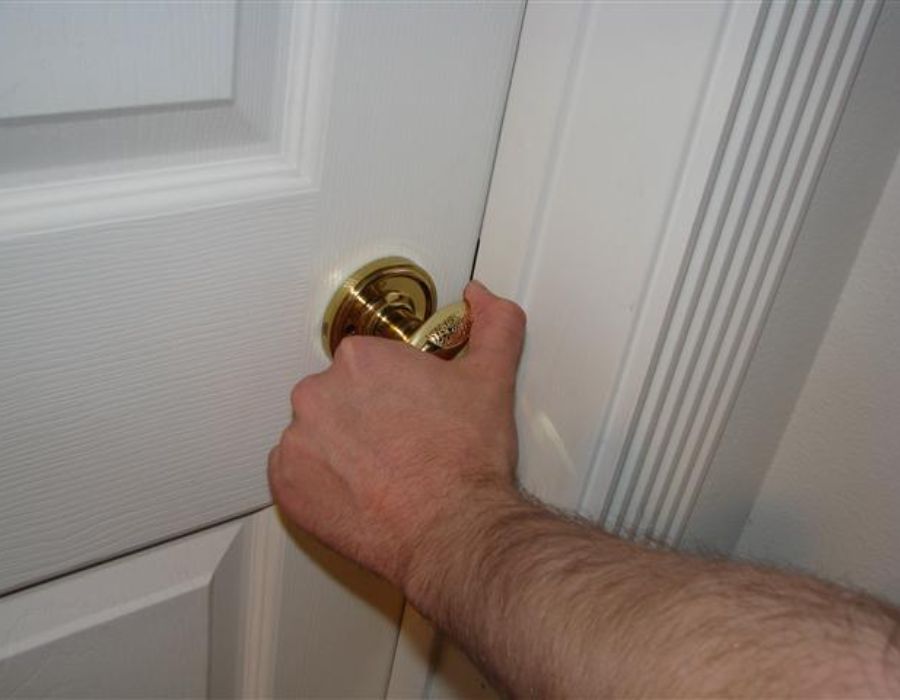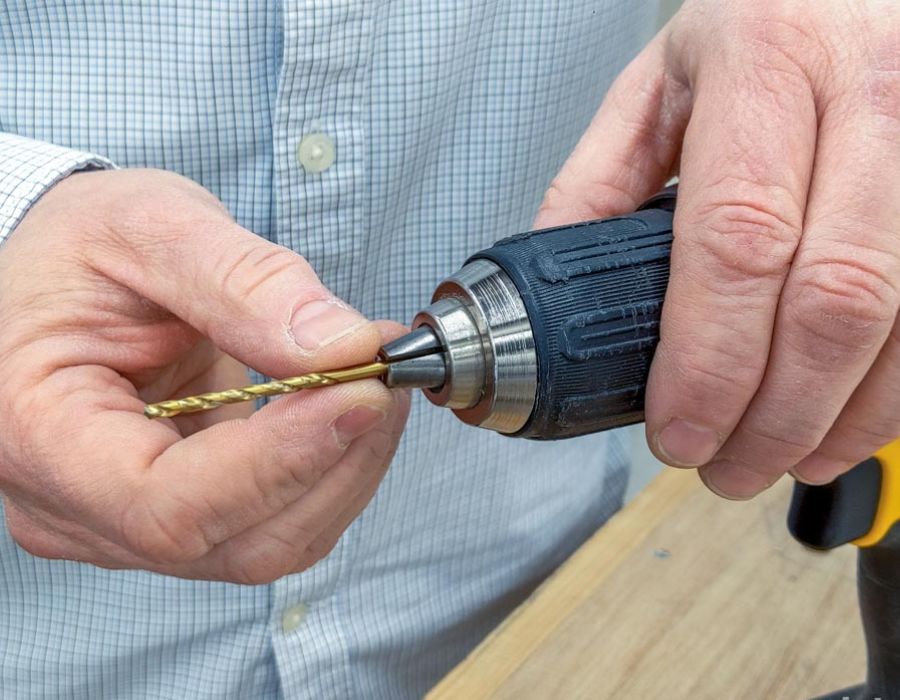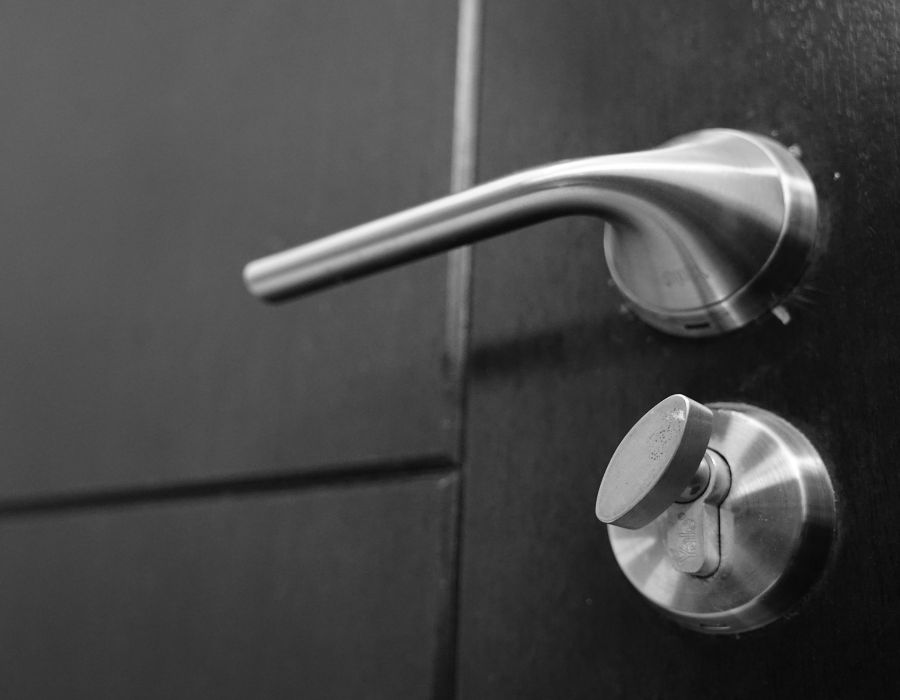Unlocking a locked bathroom door with a hole involves drilling a small opening near the doorknob, followed by using a tool or wire to manipulate the lock mechanism and regain access to the locked space.
Join us as we delve into the intricacies of this technique, equipping you with the knowledge and confidence to overcome lockouts with finesse.
Assessing the Locked Door

When faced with a locked bathroom door, it’s essential to approach the situation methodically. Begin by taking a deep breath and maintaining your composure.
Before you proceed with any unlocking attempts, ensure that the door is genuinely locked and not simply stuck due to a faulty handle or misaligned latch.
Examine the doorknob and surrounding area to identify the type of locking mechanism in use – whether it’s a basic privacy lock, a key-operated lock with a latch bolt, or a more complex electronic system. This initial assessment will guide your next steps and determine the most appropriate unlocking method to employ.
Gathering Tools and Materials
Equipping yourself with the appropriate tools and materials is a pivotal step in the process of unlocking privacy locks of bathroom doors with a hole. As you embark on this endeavor, make sure to have the following items ready:
- Drill: A power drill with a small drill bit is essential for creating a precise hole in the door near the door knob.
- Safety Gear: Prioritize safety by wearing protective gear, such as safety goggles and gloves, to shield yourself from any debris or metal shavings generated during drilling.
- Small Drill Bit: Opt for a drill bit that matches the size of the hole you intend to create, ensuring accuracy and minimal damage to the door.
- Small screwdriver, Butter Knife, or Pry Tool: You’ll need a flat-head screwdriver, butter knife, or a pry tool, but a small flathead screwdriver is best. Use it to carefully remove any components from the door knob if necessary.
- Wire or Thin Tool: Select a piece of sturdy wire or a thin tool, such as a paperclip, butter knife, or a small screwdriver, to manipulate the locking mechanism through the hole.
- Tape (Optional): Masking tape or painter’s tape can help prevent splintering or damage to the door’s surface while you work.
- Container: Have a container or small bag nearby to collect any debris or metal shavings created during the drilling process. In the absence of a suitable container, employ the plastic wrap commonly utilized for wrapping furniture during moving.
By having these tools and materials at your disposal, you’ll be well-prepared to execute each step of the unlocking process of interior doors, minimizing potential challenges and ensuring a successful outcome.
Steps to Unlock a Locked Bathroom Door with a Hole
Unlocking a bathroom door using the hole method requires a systematic approach and careful execution. Follow these steps to successfully regain access to the locked space:
Prepare the Workspace
- Put on your safety gear, including goggles and gloves, to protect yourself during the process.
- Lay down a protective covering, such as a towel or cardboard, to prevent any debris from scratching the floor or surfaces.
Identify the Drilling Spot

- Examine the door near the doorknob to locate a suitable spot for drilling. Aim for a position just above or below the doorknob, where the privacy mechanism is likely located.
Drill the Hole
- Attach the appropriate-sized drill bit to your power drill.
- Position the drill bit on the chosen spot and apply gentle pressure as you start drilling. Maintain a straight angle to create a clean hole.
- Drill slowly and steadily, periodically withdrawing the drill to remove wood shavings and prevent overheating.
Create the Hole
- Once the hole is drilled, carefully remove any wood splinters or debris around the area to ensure a clear opening.
Access the Locking Mechanism
- Insert a wire, thin tool, or a pre-bent paperclip into the small hole you’ve created.
- Feel around and gently manipulate the tool to locate and engage with the locking mechanism.
Unlock the Door
- Gradually maneuver the tool to manipulate the internal components. You may need to push, pull, or twist the tool based on the type of privacy lock in use.
- As you manipulate the lock, you should feel or hear a slight movement indicating that the lock is disengaging.
Test the Door
- Carefully turn the doorknob to check if the lock has been successfully disengaged.
- Once the door is unlocked, remove the tool from the hole.
Clean Up and Restore
- Collect any wood shavings or debris generated during the process and dispose of them properly.
- If desired, you can apply a small amount of wood filler to the small hole and sand it down to restore the door’s appearance.
Maintenance and Further Steps
- Consider lubricating the mechanism to ensure smooth future operation.
- Reflect on the experience and explore preventive measures to avoid lockouts in the future.
By following these steps meticulously, you’ll be able to navigate the process of unlocking a bathroom door with a hole, using a combination of careful drilling and skillful manipulation.
Alternatives to the Hole Method
While the hole method can be an effective way to unlock a bathroom door, it’s important to explore alternative approaches before resorting to potentially invasive measures. Here are some non-destructive methods that you can consider:
Bobby Pin or Paperclip Method
- Straighten a bobby pin or paperclip and insert it into the keyhole.
- Gently wiggle and maneuver the pin while applying slight pressure. This technique can work for simple spring-loaded push button locks.
Credit Card Technique
- Slide a flexible plastic card, such as a credit card or a driver’s license, between the door and the door frame.
- Press and wiggle the card while simultaneously turning the doorknob. This method aims to disengage the latch mechanism of a push button lock or any type of privacy lock.
Lock Pick Set

- If you have a basic understanding of lock picking, you can use a lock pick set to manipulate the lock’s pins and tumblers.
Call for Help and Don’t Knock Down the Door Frame
- Contact a family member, friend, or neighbor who might have a spare key or experience with lockouts.
Professional Locksmith
- When all else fails, or if you’re uncomfortable attempting DIY methods, consider contacting a professional locksmith. They have the expertise and specialized tools to safely unlock a locked door without causing damage. Similar to how you tip furniture delivery personnel, remember that offering a tip to the locksmith is a considerate gesture.
It’s crucial to approach these alternative methods with caution and a gentle touch to avoid causing unintended damage to the door or lock. If you decide to proceed with any of these techniques, remember to prioritize your safety and the integrity of the door while attempting to regain access.
Preventive Measures and Maintenance

Preventing future lockouts and maintaining your bathroom door’s functionality is essential for a hassle-free living environment. Consider these proactive steps to safeguard against lockouts and ensure the smooth operation of your door:
Duplicate Keys: Keep a spare key in a secure and accessible location, such as with a trusted neighbor, family member, or in a key lockbox.
Regular Inspections: Periodically check the door’s mechanism for any signs of wear or malfunction. Address minor issues promptly to prevent them from escalating.
Lubrication: Apply a small amount of graphite-based or silicone lubricant to the mechanism to prevent friction and ensure smooth operation.
Test Door Locks: Regularly test your privacy locks to ensure they are functioning correctly. This simple step can help you identify potential issues before they lead to lockouts.
Educate Family Members: Ensure everyone in your household knows how to operate the lock properly and is aware of the spare key’s location. Just as you’d take the time to comprehend how attic fans operate, it’s a good practice to gain insight into the composition and mechanism of a door set.
Secure Handles and Latches: Make sure handles and latches are properly aligned and securely fastened to avoid situations where the door becomes stuck.
Electronic Lock Maintenance: If you have an electronic lock, replace batteries as needed and follow manufacturer guidelines for maintenance.
Emergency Kit: Prepare a small emergency kit with essential tools, such as a wire or paperclip, in case lockouts occur unexpectedly.
By adopting these preventive measures and incorporating routine maintenance into your home care routine, you’ll minimize the likelihood of encountering lockouts and ensure that your bathroom door remains a reliable entry point without the need for invasive unlocking methods.
Conclusion
Mastering the technique of unlocking a bathroom door with a small hole empowers you to navigate lockouts effectively. This step-by-step process, involving careful drilling and lock manipulation, ensures a reliable solution when access is urgently needed. While the hole method serves as a valuable tool, it’s essential to explore non-destructive alternatives and professional help when appropriate. Armed with this knowledge, you’re prepared to tackle unexpected lockouts with confidence and resourcefulness. Best of luck!









